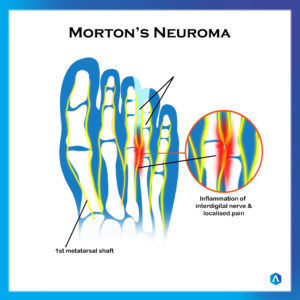Morton’s Neuroma
- Edgard Diaz
- August 19, 2019

It is caused by tissue thickening around nerves that lead to your toes creating the sharp pain experienced in the ball of the foot or make your toes sting, burn or feel numb.
With Morton’s Neuroma the pain is usually localised because it affects the nerve between the metatarsal heads. It is not to be confused with other conditions such as Metatarsalgia.
Morton’s Neuroma is often linked with high-heeled shoes and switching to lower heeled shoes with enclosed toes can provide relief.
Symptoms
There are a few different symptoms that can be confirmed by your podiatrist of health professional.
- Feeling like you are standing on a stone or there’s something in your shoe
- Experiencing burning in ball of your foot that could spread to your toes
- Numbness or pins and needles in your toes
- Sharp stabbing pain in the ball of the foot.
Assessment
To confirm Morton’s Neuroma, book a full biomechanical assessment, diagnostic and treatment program. In this situation you may also be sent for an X-ray, ultrasound or MRI.
Dr Abbie Najjarine, principal at Dr. Abbie Clinics, uses engineering principles to assess the body. Like any materials, tendons have a yield point and he has applied this to help Dr. Abbie patients understand the body’s reaction to the activities we tend to inflict on our bodies and how it applies to a particular individual’s unique body structure and situation.
Treatment
Treatment for Morton’s Neuroma are usually non-surgical. At Dr. Abbie Clinics we would look at the most immediate ways to relieve pain. This could be one or a combination of the following:
- Stop doing your exercise regime of strenuous activity and rest as much as possible
- Ice the area of pain as required during the day, you can use an ice pack or other method for this, as long as this is done for up to 20 minutes until the skin becomes numb
- Anti-inflammatory medication like Voltaren or ibuprofen help reduce swelling and pain
- Shockwave therapy, where high-energy shockwave impulses are designed to aid the healing process of the damaged area
- Dry needling helps to reduce any adhesions in the foot
- Foot mobilisation helps to realign any bones in the foot and reduce stress
- Orthotics help support the foot and take strain off the Achilles tendon and reduce irritation at the back of shoes
- A last resort would be Cortisone injections, although there is risk of tearing the tendon with this procedure.
If you’re experiencing symptoms call 1800 DR ABBIE or email reception@dr-abbie.com to organise an assessment.


